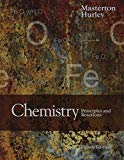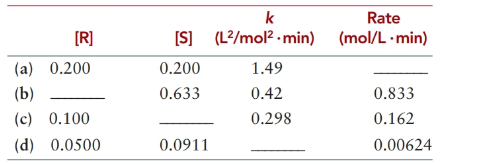
Complete the following table for the reaction

(a)
Interpretation:
To determine the rate for the given reaction.
Concept introduction:
Rate of a chemical reaction: It tells us about the speed at which the reactants are converted into products.
Mathematically, rate of reaction is directly proportional to the product of concentration of each reactant raised to the power equal to their respective stoichiometric coefficients.
Let’s say we have a reaction:
Answer to Problem 17QAP
Rate of reaction is
Explanation of Solution
Here the given chemical reaction is:
It is given that reaction is first order with respect to R and second order with respect with S. Thus, rate law for above reaction will be:
Here we have:
Concentration of R=0.200 M
Concentration of S = 0.200 M
Rate constant =1.49 L2/mol2.min
Rate of reaction = let it ‘r’
Plugging value in rate law expression:
(b)
Interpretation:
To determine the concentration of R in given reaction.
Concept introduction:
Rate of a chemical reaction: It tells us about the speed at which the reactants are converted into products.
Mathematically, rate of reaction is directly proportional to the product of concentration of each reactant raised to the power equal to their respective stoichiometric coefficients.
Let’s say we have a reaction:
Answer to Problem 17QAP
Concentration of R is
Explanation of Solution
Here the given chemical reaction is:
It is given that reaction is first order with respect to R and second order with respect with S. Thus, rate law for above reaction will be:
Here we have:
Concentration of R= let it ‘[R]’ mol/L
Concentration of S = 0.633 mol/L
Rate constant =0.42 L2/mol2.min
Rate of reaction = 0.833 mol/L.min
Plugging value in rate law expression:
(c)
Interpretation:
To determine the concentration of S in given reaction.
Concept introduction:
Rate of a chemical reaction: It tells us about the speed at which the reactants are converted into products.
Mathematically, rate of reaction is directly proportional to the product of concentration of each reactant raised to the power equal to their respective stoichiometric coefficients.
Let’s say we have a reaction:
Answer to Problem 17QAP
Concentration of S is
Explanation of Solution
Here the given chemical reaction is:
It is given that reaction is first order with respect to R and second order with respect with S. Thus, rate law for above reaction will be:
Here we have:
Concentration of R= 0.100 mol/L
Concentration of S = let it ‘[S]’ mol/L
Rate constant = 0.298 L2/mol2.min
Rate of reaction = 0.162 mol/L.min
Plugging value in rate law expression:
(d)
Interpretation:
To determine the rate constant in the given reaction.
Concept introduction:
Rate of a chemical reaction: It tells us about the speed at which the reactants are converted into products.
Mathematically, rate of reaction is directly proportional to the product of concentration of each reactant raised to the power equal to their respective stoichiometric coefficients.
Let’s say we have a reaction:
Answer to Problem 17QAP
Rate constant is
Explanation of Solution
Here the given chemical reaction is:
It is given that reaction is first order with respect to R and second order with respect with S. Thus, rate law for above reaction will be:
Here we have:
Concentration of R= 0.0500 mol/L
Concentration of S = 0.0911 mol/L
Rate constant = let it ‘k’ L2/mol2.min
Rate of reaction = 0.00624 mol/L.min
Plugging value in rate law expression:
Want to see more full solutions like this?
Chapter 11 Solutions
Bundle: Chemistry: Principles and Reactions, 8th, Loose-Leaf + OWLv2, 1 term (6 months) Printed Access Card
- Correctly name this compound using the IUPAC naming system by sorting the components into the correct order. Br IN Ν Harrow_forwardHow is the radical intermediate for this structure formed? Can you please draw arrows from the first radical to the resonance form that would result in this product? I'm lost.arrow_forwardPart VI. (a) calculate the λ max of the compound using woodward - Fieser rules. (b) what types of electronic transitions are present in the compound? (c) what are the prominent peaks in the IR spectrum of the compound?arrow_forward
- Don't used Ai solutionarrow_forwardPlease correct answer and don't used hand raitingarrow_forward↑ 0 Quiz List - RCC430M_RU05 X Aktiv Learning App × Qdraw resonance structure ×Q draw resonance structure xb My Questions | bartleby ×+ https://app.aktiv.com Draw a resonance structure of pyrrole that has the same number of pi bonds as the original structure. Include all lone pairs in your structure. + N H a 5 19°F Cloudy Q Search Problem 12 of 15 Atoms, Bonds and Rings Charges and Lone Pairs myhp हजु Undo Reset Remove Done Submit Drag To Pan 2:15 PM 1/25/2025arrow_forward
 Chemistry & Chemical ReactivityChemistryISBN:9781337399074Author:John C. Kotz, Paul M. Treichel, John Townsend, David TreichelPublisher:Cengage Learning
Chemistry & Chemical ReactivityChemistryISBN:9781337399074Author:John C. Kotz, Paul M. Treichel, John Townsend, David TreichelPublisher:Cengage Learning Chemistry & Chemical ReactivityChemistryISBN:9781133949640Author:John C. Kotz, Paul M. Treichel, John Townsend, David TreichelPublisher:Cengage Learning
Chemistry & Chemical ReactivityChemistryISBN:9781133949640Author:John C. Kotz, Paul M. Treichel, John Townsend, David TreichelPublisher:Cengage Learning Chemistry: Principles and ReactionsChemistryISBN:9781305079373Author:William L. Masterton, Cecile N. HurleyPublisher:Cengage Learning
Chemistry: Principles and ReactionsChemistryISBN:9781305079373Author:William L. Masterton, Cecile N. HurleyPublisher:Cengage Learning Chemistry: Principles and PracticeChemistryISBN:9780534420123Author:Daniel L. Reger, Scott R. Goode, David W. Ball, Edward MercerPublisher:Cengage Learning
Chemistry: Principles and PracticeChemistryISBN:9780534420123Author:Daniel L. Reger, Scott R. Goode, David W. Ball, Edward MercerPublisher:Cengage Learning ChemistryChemistryISBN:9781305957404Author:Steven S. Zumdahl, Susan A. Zumdahl, Donald J. DeCostePublisher:Cengage Learning
ChemistryChemistryISBN:9781305957404Author:Steven S. Zumdahl, Susan A. Zumdahl, Donald J. DeCostePublisher:Cengage Learning Chemistry: An Atoms First ApproachChemistryISBN:9781305079243Author:Steven S. Zumdahl, Susan A. ZumdahlPublisher:Cengage Learning
Chemistry: An Atoms First ApproachChemistryISBN:9781305079243Author:Steven S. Zumdahl, Susan A. ZumdahlPublisher:Cengage Learning





